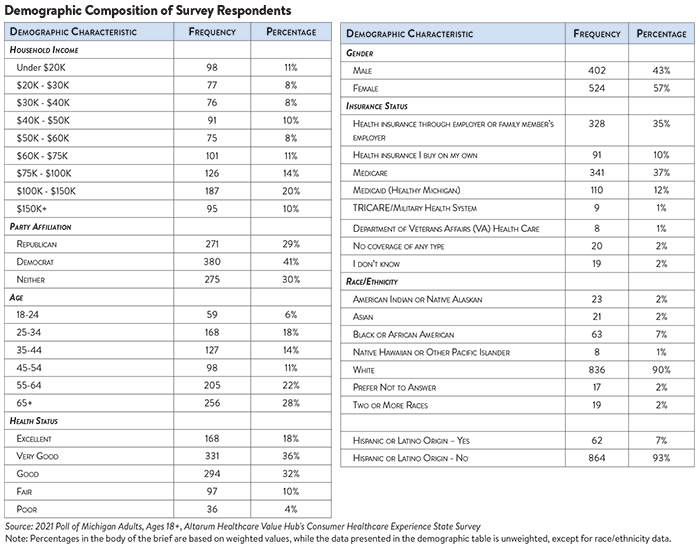Michigan Residents Struggle to Afford High Healthcare Costs; Worry About Affording Future Care; Support Government Action across Party Lines
Key Findings
A survey of over 920 Michigan adults, conducted from October 20, 2021 to December 16, 2021, found that:
- Nearly 3 in 5 (57%) experienced healthcare affordability burdens in the past year;
- Nearly 4 in 5 (78%) worry about affording healthcare in the future;
- Nearly 3 in 5 (57%) are worried about affording treatment for COVID-19 if they need it; and
- Across party lines, respondents express strong support for government-led solutions.
Survey context: During the survey period, Michigan residents were experiencing a fourth wave of COVID-19 infection and disease. Rates of hospitalization and death were trending upward. For example, the percentage of hospital patients admitted for COVID-19 increased from approximately 10% of all hospital inpatients statewide in October to 22% in December. In November 2021, Michigan’s jobless rate was 5.9%–which is 2.2 percentage points above the state’s pre-pandemic February 2020 rate.
A Range of Healthcare Affordability Burdens
Like many Americans, Michigan adults experience hardship due to high healthcare costs. All told, over half (57%) of Michigan adults experienced one or more of the following healthcare affordability burdens in the prior 12 months:
1) Being Uninsured Due to High Premium Costs
Three in five (59%) of uninsured adults cited “too expensive” as the major reason for not having coverage, far exceeding other reasons like “don’t need it” and “don’t know how to get it.”
2) Delaying or Foregoing Healthcare Due to Cost
Half (51%) of Michigan adults reported delaying or foregoing healthcare during the prior 12 months due to cost:
- 31%—Skipped needed dental care
- 30%—Skipped a recommended medical test or treatment
- 27%—Cut pills in half, skipped doses of medicine or did not fill a prescription1
- 26%—Delayed going to the doctor or having a procedure done
- 24%—Had problems getting mental healthcare or addiction treatment
- 22%—Avoided going to the doctor or having a procedure done altogether
Moreover, cost was the most frequently cited reason for not getting needed medical care, exceeding a host of other barriers like difficulty getting an appointment, transportation and lack of childcare. Of the various types of medical bills, the ones most frequently associated with an affordability barrier were dental bills, doctor bills and prescription drugs. The high prevalence of affordability burdens for these services likely reflects the frequency with which Michigan adults seek these services. Trouble paying for dental bills likely reflects lower rates of coverage for these services.
3) Struggling to Pay Medical Bills
Other times, Michigan adults got the care they needed but struggled to pay the resulting bill. Over one-third (34%) of Michigan adults experienced one or more of these struggles to pay their medical bills:
- 15%—Used up all or most of their savings
- 11%—Were contacted by a collection agency
- 9%—Borrowed money, got a loan or another mortgage on their home
- 9%—Were unable to pay for basic necessities like food, heat or housing
- 8%—Racked up large amounts of credit card debt
- 6%—Were placed on a long-term payment plan
High Levels of Worry About Affording Healthcare in the Future
Michigan adults also exhibit high levels of worry about affording healthcare in the future. Four in five (78%) report being “worried” or “very worried” about affording some aspect of healthcare in the future, including:
- 65%—Health insurance will become unaffordable
- 63%—Cost of affording nursing home or home care services
- 61%—Medical costs when elderly
- 60%—Medical costs in the event of a serious illness or accident
- 53%—Prescription drugs will become unaffordable
- 52%—Cost of dental care
While two of the most common worries—affording the cost of nursing home or home care services and medical costs when elderly—are applicable predominantly to an older population, they were frequently reported by respondents ages 25-54. This finding indicates that Michigan residents may be worried about affording the cost of care for aging parents, in addition to themselves.
Furthermore, 41% of respondents of all ages are “worried” or “very worried” about losing their health insurance. Concerns about affording health insurance exceeded fears about losing coverage across all insurance types (see Figure 1). Half to three-fourths of respondents in the four coverage categories below were “worried” or “very worried” about not being able to afford health insurance in the future. In addition, respondents with private insurance reported higher rates of concern about affording health insurance in the future than those with Medicare or Medicaid.
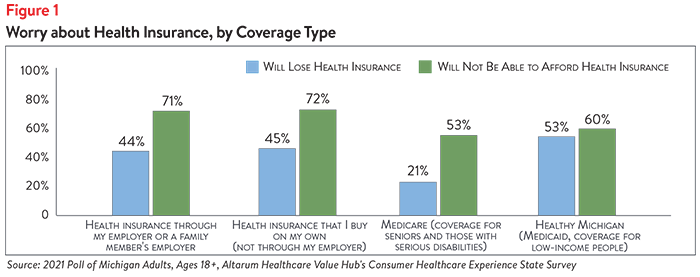
Worry about affording healthcare in the future was relatively consistent between rural and non-rural areas of the state, with nearly 4 in 5 residents reporting having at least one healthcare affordability worry in the prior 12 months (see Table 1). Healthcare affordability worries were similarly high across the income spectrum but were highest among those earning less than $50,000 per year and those earning between $75,000 and $100,000 per year.
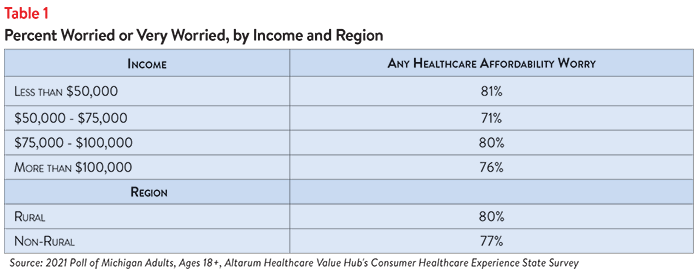
Worries about losing health insurance and health insurance becoming unaffordable, specifically, are also more prevalent among certain groups of Michigan residents. Notably, 49% of those earning more than $100,000 per year worry about losing their health insurance, compared to 29% of those in the $50,000-$75,000 income bracket (see Table 2). While large shares of Michiganders across the income spectrum worry about health insurance becoming unaffordable, those earning between $75,000 and $100,000 per year were most likely to be concerned.
Differences in Healthcare Affordability Burdens
The survey also revealed differences in how Michigan adults experience healthcare affordability burdens by income. Interestingly, respondents at the lowest and highest ends of the income spectrum most frequently reported affordability burdens, with more than 3 in 5 (63%) of those earning less than $50,0002 AND more than $100,000 reporting struggling to afford healthcare in the past 12 months (see Figure 2). Respondents in these income groups also reported the highest rates of foregoing care, however, high-income earners were significantly more likely to ration their medication due to cost (see Figure 3).

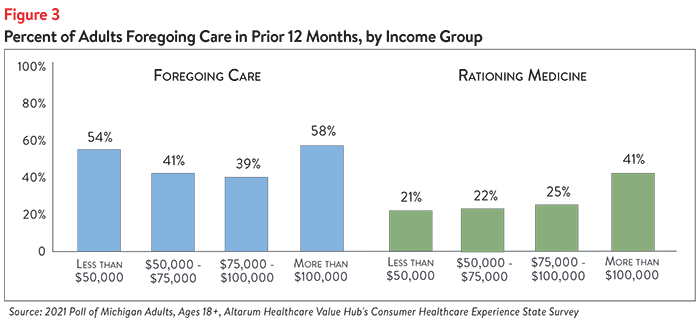
Further analysis found that people ages 18 to 45 were more likely to forego care and ration medications than older respondents. Seventy-nine percent of 18 to 24-year-olds reported forgoing needed care.
Michiganders living in non-rural areas of the state reported slightly higher rates of rationing care than rural residents (see Table 3).
COVID Worries
In addition to affordability worries, respondents were asked about their top worries related to the COVID crisis. When asked about “affording treatment of coronavirus/COVID-19 if you need it,” 57% of respondents reported being somewhat or very worried.
Separately, out of twelve possible responses, respondents were asked to pick the top three things they were most worried about. “Becoming ill from the virus” was most frequently selected by respondents at 55%, exceeding other worries by a wide margin (see Table 4).
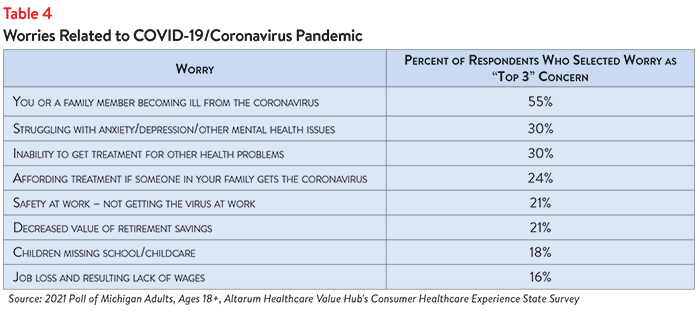
In smaller numbers, Michigan adults worry about many other issues, including: ability to vote safely (11%) and unavailability of COVID treatment if they or a family member gets sick (10%).
Though the increased availability of COVID-19 vaccines may have somewhat lessened worries surrounding the virus, it is important to note that 3 in 5 respondents (57%) remain somewhat or very worried about not being able to afford treatment for COVID-19 if they need it.
Dissatisfaction with the Health System and Support for Change
In light of their healthcare affordability and COVID concerns, it is not surprising that Michigan residents are extremely dissatisfied with the health system. Statewide:
- Just 39% agreed or strongly agreed that “we have a great healthcare system in the U.S.,”
- While 75% agreed or strongly agreed that “the system needs to change.”
To investigate further, the survey asked about both personal and governmental actions to address health system problems.
Personal Actions
Michigan residents see a role for themselves in addressing healthcare affordability. When asked about specific actions they could take:
- 57% of respondents reported researching the cost of a drug beforehand, and
- 73% said they would be willing to switch from a brand name to an equivalent generic drug if given the chance.
When asked to select the top three personal actions that would be most effective in addressing healthcare affordability (out of ten options), the most common responses were:
- 66%—Take better care of my personal health
- 37%—Research treatments myself, before going to the doctor
- 35%—Write or call my STATE representative asking them to take action
- 30%—Write or call my FEDERAL representative asking them to take action
Government Actions
But far and away, Michigan residents see government as the key stakeholder that needs to act to address health system problems. Moreover, addressing healthcare problems is a top priority that Michigan residents want their elected representatives to work on.
At the beginning of the survey, respondents were asked what issues the government should address in the upcoming year. The top vote getters were:
- 59%—Healthcare
- 57%—Economy/Joblessness
- 37%—Taxes
When asked about the top three healthcare priorities the government should work on, the top vote getters were:
- 53%—Address high healthcare costs, including prescription drugs
- 33%—Preserve consumer protections preventing people from being denied coverage or charged more for having a pre-existing medical condition
- 32%—Get health insurance to those who cannot afford coverage
- 32%—Improve Medicare, coverage for seniors and those with serious disabilities
Of more than 20 options, Michigan adults believe the reason for high healthcare costs is unfair prices charged by powerful industry stakeholders:
- 71%—Drug companies charging too much money
- 69%—Hospitals charging too much money
- 69%—Insurance companies charging too much money
When it comes to tackling costs, respondents endorsed a number of strategies, including:
- 94%—Make it easy to switch insurers if a health plan drops your doctor
- 93%—Show what a fair price would be for specific procedures
- 93%—Require insurers to provide up-front cost estimates to consumers
- 92%—Require hospitals and doctors to provide up-front cost estimates to consumers
- 91%— Expand health insurance options so that everyone can afford quality coverage
There were also high levels of support for strategies to lower prescription drug costs:
- 94%—Require drug companies to provide advance notice of price increases and information to justify those increases
- 91%—Set standard prices for drugs to make them affordable
- 91%—Authorize the Attorney General to take legal action to prevent price gouging or unfair prescription drug price hikes
- 90%—Prohibit drug companies from charging more in the U.S. than abroad
Support for Action Across Party Lines
There is also remarkable support for change regardless of respondents' political affiliation, both generally (see Table 5) and for healthcare pricing solutions specifically (see Table 6).
Policies to Address COVID Concerns
In addition to their views on the policies and approaches above, respondents were asked about support for and against policies related to the COVID crisis. Out of eleven possible responses, respondents were asked to pick the top three policies that would help address COVID-related problems. There was significant diversity in the policies supported, with the highest percentages of respondents selecting “Universal health coverage for all” and “Improved public health emergency preparedness” as a top three priority (see Table 7). “More financial help for large businesses” received the least support, as it was a priority for only a small percentage of respondents.
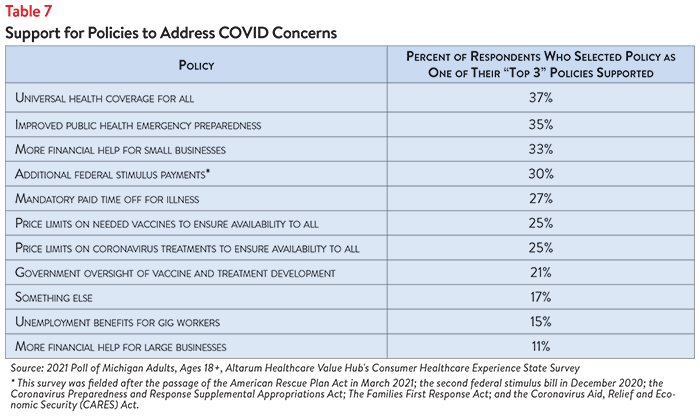
When respondents were asked about which policies they did NOT support, 32% indicated that they did not support “More financial help for large businesses.” Trailing behind that was 28% of respondents not supporting “Universal health coverage for all,” although a higher percentage of respondents indicated support. In this area, there was a lack of agreement across party lines, with Republicans far more likely to NOT support “Universal health coverage for all” as a means to address COVID-19 concerns, compared to Democrats and those not affiliated with either party (see Table 8).

It is important to note, however, that when asked generically about “Expanding health insurance options so that everyone can afford quality coverage,” 91% of respondents agreed or strongly agreed with this policy as a means of improving affordability, with high levels of support across party lines. When asked about the policies they did NOT support, respondents were given the option of selecting “I support all of the policies listed”—29% of respondents selected this option.
The high burden of healthcare affordability, along with high levels of support for change, suggest that elected leaders and other stakeholders need to make addressing this consumer burden a top priority. Moreover, the current COVID crisis is leading state residents to take a hard look at how well health and public health systems are working for them, with strong support for a wide variety of actions. Annual surveys can help assess whether or not progress is being made.
Notes
1. Of the current 51% of Michigan adults who encountered one or more cost-related barriers to getting healthcare during the prior 12 months, 18% did not fill a prescription, while 20% cut pills in half or skipped doses of medicine due to cost.
2. Median household income in Michigan was $57,144 (2015-2019). U.S. Census, Quick Facts. Retrieved from: U.S. Census Bureau QuickFacts: Michigan
Methodology
Altarum’s Consumer Healthcare Experience State Survey (CHESS) is designed to elicit respondents’ unbiased views on a wide range of health system issues, including confidence using the health system, financial burden and views on fixes that might be needed.
The survey used a web panel from Dynata with a demographically balanced sample of approximately 1,000 respondents who live in Michigan. The survey was conducted in English or Spanish and restricted to adults ages 18 and older. Respondents who finished the survey in less than half the median time were excluded from the final sample, leaving 926 cases for analysis. After those exclusions, the demographic composition of respondents was as follows, although not all demographic information has complete response rates:
